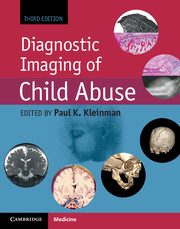Book contents
- Frontmatter
- Dedication
- Contents
- List of Contributors
- Editor’s note on the Foreword to the third edition
- Foreword to the third edition
- Foreword to the second edition
- Foreword to the first edition
- Preface
- Acknowledgments
- List of acronyms
- Introduction
- Section I Skeletal trauma
- Section II Abusive head and spinal trauma
- Section III Visceral trauma and miscellaneous abuse and neglect
- Section IV Diagnostic imaging of abuse in societal context
- Section V Technical considerations and dosimetry
- Index
Foreword to the third edition
Published online by Cambridge University Press: 05 September 2015
- Frontmatter
- Dedication
- Contents
- List of Contributors
- Editor’s note on the Foreword to the third edition
- Foreword to the third edition
- Foreword to the second edition
- Foreword to the first edition
- Preface
- Acknowledgments
- List of acronyms
- Introduction
- Section I Skeletal trauma
- Section II Abusive head and spinal trauma
- Section III Visceral trauma and miscellaneous abuse and neglect
- Section IV Diagnostic imaging of abuse in societal context
- Section V Technical considerations and dosimetry
- Index
Summary
The only real voyage of discovery consists not in seeking new landscapes, but in having new eyes.
Marcel Proust, In Search of Lost TimeThroughout history, humanity has tended either to turn a blind eye on the abuse of children or to deny its existence. Since 1962, when Kempe and Silverman wrote their landmark article on the battered child, the scientific community has developed an increasing awareness of the issue. In recent years, our understanding of the imaging findings in battered children has increased substantially thanks to the two previous editions of the most authoritative book on the subject, Diagnostic Imaging of Child Abuse, by Dr. Paul Kleinman. The book is not just a review of findings in the literature; it is the summation of decades of outstanding research, deep thought and great teaching. In his journey to clarify the nature of the radiologic manifestations of child abuse, Dr. Kleinman now looks at the subject for a third time, with “new eyes.” With this third edition, Dr. Kleinman has taken a large step to increase the depth and extent of what was included in the prior editions.
The new edition begins with a chapter about the structure, growth, and development of the skeleton by Professor Andrew Rosenberg, a premier pathologist in the United States. The first two chapters also deal with important concepts about the pathophysiology of skeletal injury, which are fundamental to the understanding of the imaging manifestations of skeletal trauma. The following chapters are divided regionally, dealing with specific findings that are related to the particular bone that is injured. Six chapters address the differential diagnosis of abusive skeletal injury. At a time where there is discussion about the etiology of many radiologic findings, particularly in the metaphysis, this book provides a brilliant guide to differentiating inflicted traumatic findings from many potential mimickers. The chapters on the differentiation from normal variants and other sources of trauma reflect the meticulous research performed by Dr. Kleinman. The chapter on disorders of calcium and phosphorus metabolism, co-authored by Dr. Ingrid Holm, an expert in metabolic bone disease, and Dr. Jeannette Perez-Rossello, who has studied the subject in great depth, is particularly important.
- Type
- Chapter
- Information
- Diagnostic Imaging of Child Abuse , pp. xiiPublisher: Cambridge University PressPrint publication year: 2015



